My Catholic father wishes I published more photos of churches from my travels. The fire of Notre Dame in Paris had an impact on me. My wife and I saw Notre Dame years ago on a night cruise of the Seine on her only trip to Paris. I had walked through the cathedral a couple years before that cruise, probably around 2000. I did not own a digital camera then. I don’t even remember why I was in Paris.
Kelley asked me, “How did it feel walking around inside Notre Dame?”
“The experience brought tears to my eyes. I was overwhelmed with emotion.”
She thought I was joking. I am an atheist.
I also have a love for studying history.
The destruction of monumental history is a profound loss, whether it is Notre Dame Cathedral in Paris or the Al ‘Askarī Shrine bombed in 2006 in Samarra, Iraq or the Buddhas of Bamiyan, Afghanistan destroyed in 2001 or the destruction of hundreds of churches and castles and cities in war. Syria has many of the oldest continuously inhabited cities in human history and a civil war destroying much of that history.
So much destruction of monuments – some intentional, some caught in the crossfire of war, some by chance, some by stupid accident.
My travels through Germany and Poland have shown me entire cities rebuilt from ruins.
Dresden Frauenkirche was still mostly ruins with labeled blocks lying in the streets when I first walked around the church 20 years ago, more than 50 years after the fire bombing of Dresden in February 1945.
I returned to Dresden in 2007 to find a completely reconstructed Frauenkirche.
Notre Dame Cathedral will be rebuilt.
St. Vitus Cathedral Prague
Prague is the largest city (1.3 million) in Central Europe with much of its medieval architecture intact. What I find unique about Prague are large sections of the city reveal architectural styles from many centuries. One can walk streets all day around large sections of Prague surrounded by historic architecture. Prague is the largest city in the former Habsburg Empire to survive WW2 relatively unscathed, except for a February 1945 errant carpet bombing by Americans who were supposed to be over Dresden, Germany.
Two weeks ago I was walking around the outside of St. Vitus Cathedral at Prague Castle. The official name is The Metropolitan Cathedral of Saints Vitus, Wenceslaus and Adalbert. I find St. Vitus is one of the most beautiful cathedrals in Europe I have seen. The castle is situated within the walls of Prague Castle. Visitors to the castle are required to go through a security checkpoint before accessing the streets within the castle complex. Prague Castle is one of the world’s largest castles. Unfortunately, Kelley and I arrived too late in the day for a tour of the Cathedral interior.
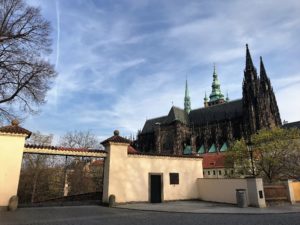
There has been a church within the walls of Prague Castle since 930. The current Gothic Cathedral was started in 1344 when King John of Bohemia laid the foundation stone. St. Vitus Cathedral gained prominence during the reign of Charles IV, born in Prague and son of King John. Charles IV became King of Italy, King of Burgundy and Holy Roman Emperor.
Charles IV summoned Matthias of Arras from the Papal Palace at Avignon, France to be master builder for church construction. Matthias planned a French Gothic church design but died in 1352 with only the eastern parts built.
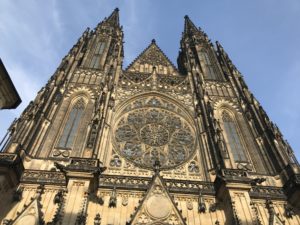
Rose window on the west side of St. Vitus Cathedral is one of the last features completed in 1925-27, nearly 600 years after the cathedral was started.
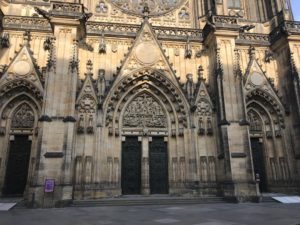

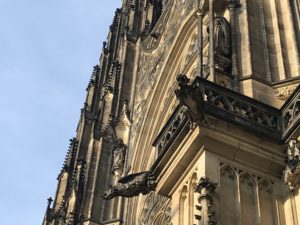
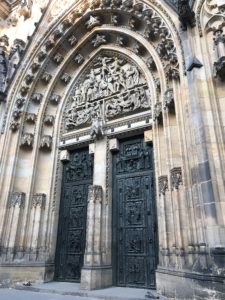
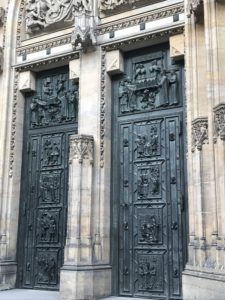

Peter Parler, son of a German architect, succeeded as master builder and the work continued under the leadership of his sons into the early 1400s when construction was halted during a revolutionary period in Czech history. Troubles in Prague escalated in the early 1400s as Jan Hus sparked a Roman Catholic church reform movement across Bohemia. His execution in 1415 when he was burned at the stake in Constance as a heretic motivated his Hussite followers into revolution against the Catholic Church, Holy Roman Empire and Papacy. Crusaders were sent to Bohemia in a series of battles known as the Hussite Wars (1419-1434).
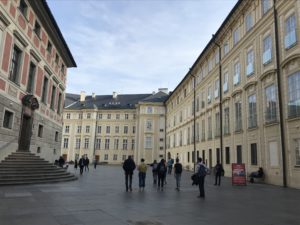
Prague Castle is a castle complex within walled grounds consisting of several palaces, churches and St. Vitus Cathedral. The original castle was founded around 880 by Prince Bořivoj of the Premyslid Dynasty. There are architectural styles within the complex dating from 10th century Romanesque to 14th century Gothic with most palace structures from more recent eras.
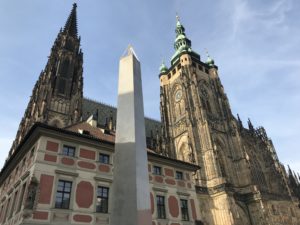
The 16 meter obelisk in the Prague Castle courtyard on the south side of St. Vitus Cathedral was installed in 1928 for the 10th anniversary of the founding of Czechoslovak Republic in 1918 after the fall of the Austro-Hungarian Empire. The obelisk was intended to be taller, but broke in two on transport to the castle. The Velvet Revolution of 1989 saw the relatively peaceful political transition from post-WW2 Communist party rule to parliamentary democracy in Czechoslovakia. Perhaps the broken obelisk of 1928 predetermined the Velvet Divorce of January 1, 1993 when Czechoslovakia peacefully separated into the nations of Czech Republic and Slovakia.

From the courtyard ground level it is difficult to tell which part of St. Vitus Cathedral is the tallest, the steeples or the Great South Tower?
The Great South Tower at 102.8 meters/337 feet high was initially started under Peter Parlor in the late 14th century, however the tower was not completed until the 16th century in a different architectural style. The tower is open to visitors who wish to climb 287 steps to the viewing gallery. The current dome was added in the 18th century.
The Twin Steeples are 82 meters/269 feet high and a much later 19th century addition to the Cathedral when architect Josef Mocker designed the western facade of St. Vitus Cathedral and the steeples in Neo-Gothic style.
The Golden Gate – Ceremonial Royal Entrance
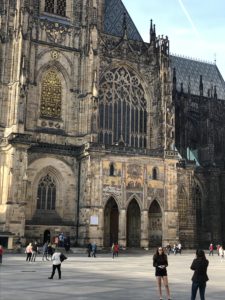
Three arches of the Golden Gate is the ceremonial entrance to St. Vitus Cathedral for coronations and funerals. This part of the cathedral was designed by Peter Parler in the 14th century. A mosaic of the Last Judgment adorns the wall over the arches.
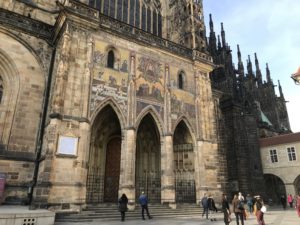
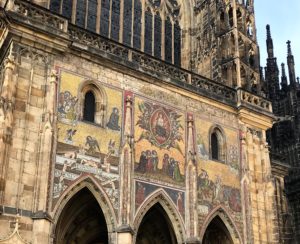
Charles IV commissioned The Last Judgment mosaic in 1371. The mosaic recently underwent a ten-year restoration project.
It is likely that Charles IV, king of Bohemia and the Holy Roman Emperor, noticed the “dimming†of his
mosaic. He commissioned the work in 1371 for the southern entrance of the cathedral to symbolize the
magnificence of his kingdom. Called the Golden Gate, as much of it was gilded, the mosaic is made of more
than a million red, blue, and other brilliantly colored tesserae. It is composed of three panels 4 meters wide by 8 meters high, and is considered to be the most important mosaic north of the Alps.CONDITION SURVEY OF THE LAST JUDGEMENT MOSAIC ST. VITUS CATHEDRAL, PRAGUE
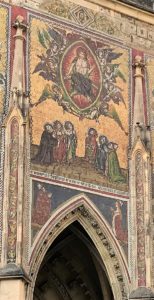
The Last Judgment mosaic center panel depicts six patron saints of Bohemia:
Above the arch and below the saints are depictions of Charles IV (1316-1378), Holy Roman Emperor and his 4th wife Elizabeth of Pommerania. She was the granddaughter of Casimir III, King of Poland and crowned Empress of the Holy Roman Empire in 1368 by Pope Urban V in Rome. Both Charles IV and Elizabeth are interred in the Royal Crypt of St. Vitus Cathedral.
Often I have no idea of the significance of the art and structures I gaze at in my travels. I will be in Prague again in summer 2019 and will attempt to take better photographs of the Last Judgment mosaic.
What fascinated more me at the time were the metal figurines depicting scenes of everyday activities on the wrought iron gates across the entrance of the Golden Gate arches.
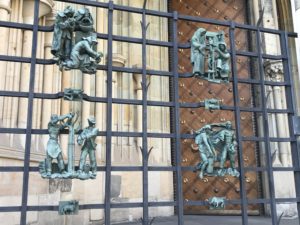
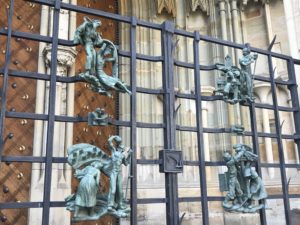
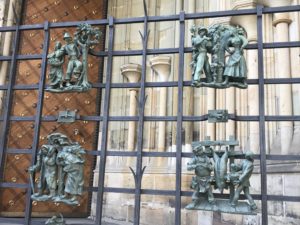
In our modern age of architecture where we can take an elevator and whisk to over 1,000 feet inside some of the world’s tallest buildings, it is difficult to imagine what one would have felt 400 years ago gazing at the grandeur of a massive tower on a hill reaching into the heavens.
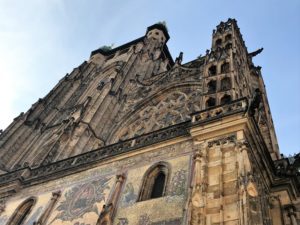
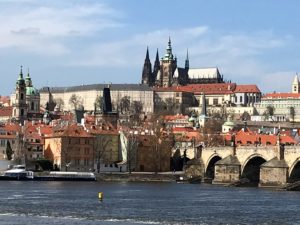
A doorway on the south side of St. Vitus Cathedral shows the emblem of the Kingdom of Bohemia.
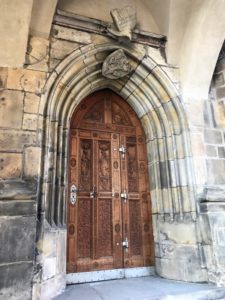
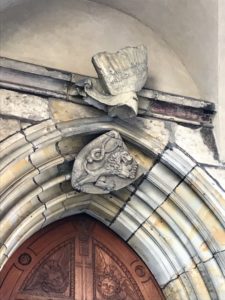
The sculptured portal is from the original 14th c. cathedral structure built in the time of Matthias of Arras. The Emblem for the Kingdom of Bohemia rests diagonally over the portal. The carved oak doors were installed in 1679 and depict St. Peter, St. Paul and Archangel Michael.

The eastern portion of St. Vitus Cathedral is the oldest Gothic architecture with flying buttresses.
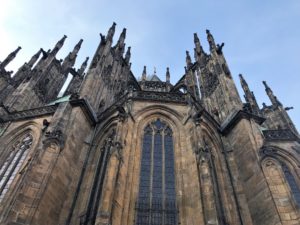
St. George’s Basilica
Across the square from the east side of St. Vitus Cathedral is St. George’s Basilica, the original church within Prague Castle established in 920. Saint Ludmila is buried in the Basilica.
There was a 17:30 choral concert happening inside St. George’s Basilica while we were visiting the castle. The doors were closed before the concert began, so not even a chance to hear voices drifting out into the courtyard.
The Baroque facade of St. George’s Basilica is from the late 1600s.
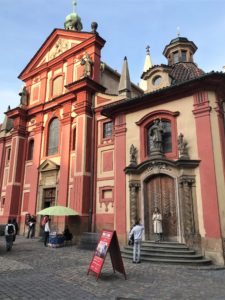
We talked about returning to Prague Castle on another day and touring the inside of St. Vitus Cathedral. We never made it back to Prague Castle during the week.
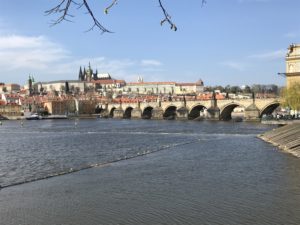
Links: Prague Castle for Visitors (official website)


